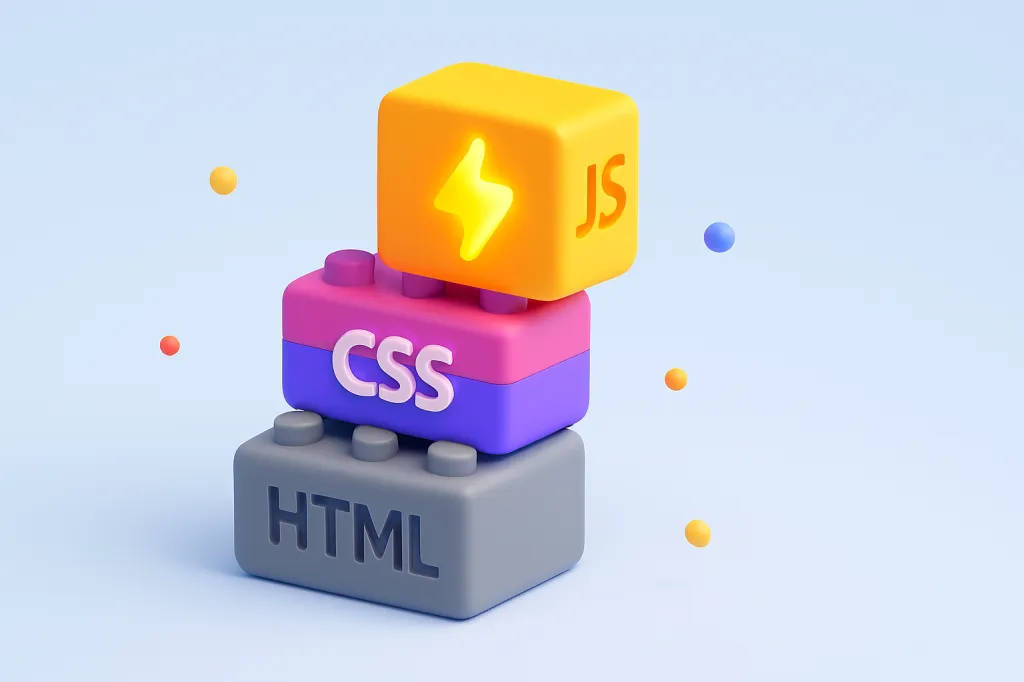If you're starting your journey into web development, you'll immediately encounter three core technologies: HTML, CSS, and JavaScript. For beginners, it can be confusing to understand what each one does and how they relate to each other. This guide will clarify their distinct roles using a simple analogy: building a house.
Table of Contents
1. HTML: The Structure (The House's Framework)
HTML stands for HyperText Markup Language. Its one and only job is to provide the structure and content of a web page. It's the skeleton that holds everything together.
The House Analogy: Think of HTML as the foundation, wooden frame, walls, and roof of your house. It defines the core structure—where the kitchen is, where the bedrooms are, the presence of doors and windows—but it's just the raw, unpainted structure. It's functional, but not pretty.
What HTML Does:
- Creates headings (
<h1>to<h6>) - Defines paragraphs (
<p>) - Places images (
<img>) - Creates links (
<a>) - Builds forms (
<form>,<input>)
Without HTML, you have no webpage, just a blank document.
2. CSS: The Style (The Decoration and Paint)
CSS stands for Cascading Style Sheets. Its job is to take the raw structure provided by HTML and make it look good. CSS is all about presentation and styling.
The House Analogy: If HTML is the house's frame, CSS is every aesthetic choice you make. It's the paint color on the walls, the style of the furniture, the font of the house number, the curtains on the windows, and the landscaping in the garden. It turns a raw structure into a visually appealing home.
What CSS Does:
- Controls colors and backgrounds
- Defines fonts, text sizes, and spacing
- Creates multi-column layouts (using Flexbox or Grid)
- Adds animations and visual effects
- Makes a site responsive, so it looks good on both desktop and mobile
Without CSS, every website would look like a plain, black-and-white document from the 1990s.
3. JavaScript: The Functionality (The Electricity and Plumbing)
JavaScript (JS) is a full-fledged programming language. Its job is to make web pages interactive and dynamic. While HTML is structure and CSS is style, JavaScript is all about functionality.
The House Analogy: JavaScript is the functional part of your house. It's the electricity that lets you turn on the lights, the plumbing that makes the faucets work, the doorbell that rings when someone pushes the button, and the garage door that opens automatically. It makes the house do things.
What JavaScript Does:
- Creates interactive image sliders and pop-up alerts
- Validates form submissions before they are sent to a server
- Updates parts of a webpage without needing to reload the entire page (like a live chat or a social media feed)
- Animates elements on the page based on user actions
- Powers complex web applications, from games to productivity tools
Without JavaScript, web pages would be static and non-interactive, like reading a book instead of using a tool.
4. How They Work Together
You cannot have a modern, functional, and beautiful website with just one of these technologies. They are designed to work as a team:
HTML builds the structure.
CSS styles that structure to make it visually appealing.
JavaScript adds interactivity to that styled structure.
Every single website you visit, from Google to Facebook to StartWithSite, is built using these three fundamental technologies working together in your browser.
Conclusion
Understanding the distinct roles of HTML, CSS, and JavaScript is the first and most important step in your web development journey. Remember the house analogy: HTML is the frame, CSS is the paint and decor, and JavaScript is what makes everything work. Master how these three work together, and you'll be well on your way to building anything you can imagine on the web.





